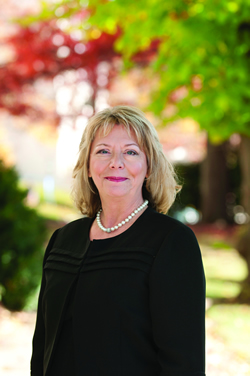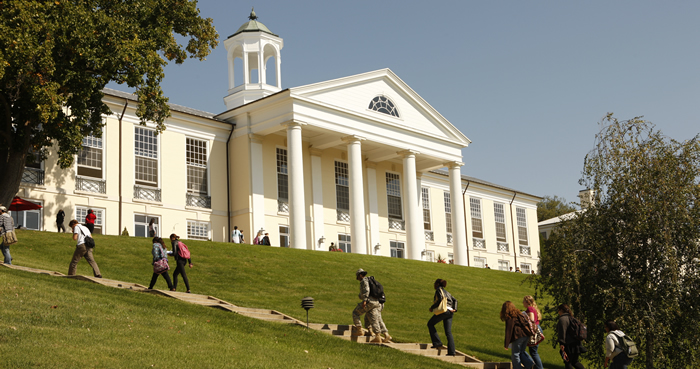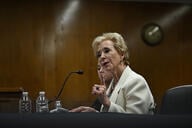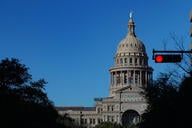You have /5 articles left.
Sign up for a free account or log in.
In March 2013, when the Faculty Senate at Mary Baldwin College met with the college’s president, tensions were running high. Professors at the private women’s college in Staunton, Va. had not received raises in six years. And a mandate from the Board of Trustees instructing faculty to examine low-enrollment majors had ignited rumors. Professors worried the college would cut certain liberal arts programs: French, Spanish, chemistry and other majors that attracted few students. Surrounded by her colleagues, Ivy Arbulú, an associate professor of Spanish, spoke.
“There are no ‘expendable’ majors, and most certainly not if what is expendable and what is not is decided by the popularity of majors amongst our students,” she said. “All majors are part of the education we offer.”
The Spanish professor, known at Mary Baldwin for her rigorous standards and dedication to students, died of leukemia six weeks later. She left behind a Spanish department with just one faculty member. In September, an interdisciplinary major in Latin American Literatures and Cultures will replace the traditional Spanish major Arbulú championed. The French major, too, has been cut, and a number of upper-level course offerings in liberal arts are being phased out.
Interviews with top college officials and a number of professors (most of whom requested anonymity for fear of reprisal), as well as a review of more than a hundred pages of internal documents obtained by Inside Higher Ed, reveal an institution in transition -- and in conflict. At Mary Baldwin, the administration’s focus on enrollment growth through new programs has left some faculty members convinced that the liberal arts college no longer has liberal arts at its center.
College officials maintain the institution has not strayed from its liberal arts mission. What’s occurring at Mary Baldwin, they say, is a philosophical dispute. A handful of professors are clinging to a conception of the liberal arts grounded in discrete disciplines -- an idea college officials say is outdated.
“We’re at a time in education when we’re moving beyond the disciplines that were created 100 years ago,” said Sarah Flanagan, chair of the academic affairs committee on Mary Baldwin’s Board of Trustees and vice president for government relations and policy at the National Association of Independent Colleges and Universities.
In recent years, many higher education experts have deemed many liberal arts colleges and women’s colleges -- at least those without billion-dollar endowments -- financially challenged, if not endangered.
Randolph College, which was another women’s institution in Virginia, opened its doors to men in 2007. Mary Baldwin, by contrast, has no plans to go coed. In the last five years, the tuition-dependent college has sought to reposition itself in an unforgiving market through other means: by investing in online learning and adult learning, by introducing new schools and by rethinking its liberal arts curriculum.
Although the residential college remains single-sex, the institution admits men to its adult degree program and its graduate programs.
A new six-year strategic plan, which the college’s Board of Trustees endorsed Thursday, reinforces the institution’s ongoing metamorphosis.
“They’ve certainly been far more entrepreneurial and willing to try things that many other institutions won’t,” said David Breneman, the Newton and Rita Meyers Professor in Economics of Education at the University of Virginia.
Pamela Fox, Mary Baldwin’s president (photo at right), put it another way. “Some people say we’re pretty scrappy,” she said.
 Indeed, the college’s recent upheavals are not altogether inconsistent with Mary Baldwin’s history. The institution launched the first adult degree program in Virginia, enrolls women as young as 13 in a gifted students' education program, and created a female military leadership institute in the 1990s when the Virginia Military Institute was trying to remain all-male.
Indeed, the college’s recent upheavals are not altogether inconsistent with Mary Baldwin’s history. The institution launched the first adult degree program in Virginia, enrolls women as young as 13 in a gifted students' education program, and created a female military leadership institute in the 1990s when the Virginia Military Institute was trying to remain all-male.
Yet even at an institution known for taking risks, the pace of change in the last few years has struck some faculty as unusual. In addition to eliminating the French major and restructuring the Spanish major, the college has cut its religion major and in its place launched an interdisciplinary program in philosophy, religious studies and culture. Meanwhile, the institution has launched programs in interdisciplinary liberal arts fields such as American studies and Renaissance studies. Career-oriented programs in criminal justice and marketing and communication have also joined the residential college's academic offerings.
Examining the college’s post-recession restructuring – a stretch of time Fox described as “intense” – offers a glimpse at the variegated challenges that liberal arts colleges face in trying to remain financially viable without compromising their missions. For Mary Baldwin, this task has entailed a redefinition of terms. College officials have sought to persuade faculty to reconsider what liberal arts education consists of. And in the process, the institution has raised questions about what “counts” as a liberal arts college after all.
An Eye on Growth
Mary Baldwin will launch two new schools this fall: a college of education and the Murphy Deming College of Health Sciences.
These two colleges will join Mary Baldwin’s three existing schools: a non-residential adult degree program of about 550 students; a small graduate program in Shakespeare and performance; and the residential college at the institution’s heart, a liberal arts-focused campus that enrolls roughly 750 female students. In a recent shift in practice, new faculty hired in the residential college will be expected to teach "across the college -- some courses in a hybrid format, some courses in the graduate programs," Fox said.
College officials say Mary Baldwin must expand in order to flourish. “You need diverse revenue streams,” Flanagan, the board member, said.
This expansion will protect Mary Baldwin’s liberal arts core by bolstering the institution’s overall finances, college officials argue. The residential college for women costs more money than it brings in. Officials expect the college of health sciences, on the other hand, to be profitable.
Crista Cabe, Mary Baldwin’s vice president for public relations, said at least half the profits from the college of health sciences will support other parts of the institution.
Although some professors said they felt optimistic about Murphy Deming, many have found it painful to watch Mary Baldwin invest in other areas as faculty wages stagnate. The college has also cut pension contributions – from 7.5 percent of an employee’s salary to 3 percent. (Between July 2010 and July 2011, the college eliminated retirement benefits entirely.)
In addition, the construction of the Murphy Deming, a three-story building seven miles away from Mary Baldwin’s main campus, took place at a time when some of the main campus’s infrastructure was deteriorating. In October 2013 the college had $4.6 million worth of deferred maintenance, board committee minutes show. The main campus’s sciences building stands half-renovated. One professor said some faculty had to move out of their offices because of mold and water leakage.
Multiple professors lamented the peeling paint, poor climate control and leaking ceilings on the historic Staunton campus – and said the campus’s liberal arts curriculum had similarly decayed.

Mary Baldwin's historic main campus in Staunton, Va.
For Mary Baldwin to boost enrollment, however, expanding outward – rather than beefing up the residential college – seemed to administrators like the only option. In strategic plans composed in 2004 and 2010, Mary Baldwin sought to increase enrollment on the main campus to 1,000 students. Now, the college has quietly abandoned that goal, instead setting its sights on graduate programs and adult degree programs.
The latest strategic plan shows that the college hopes to increase enrollment from roughly 1,700 students today to as many as 2,500 by 2020. Most of these new students will enroll in Murphy Deming or in distance-learning initiatives through the adult degree program. The size of the residential college will remain the same.
A resolution the Board of Trustees passed last April calls on Mary Baldwin to assess the feasibility of a name change from “college” to “university” – to “Baldwin University,” for example.
A Period of Unease
Arbulú’s defense of liberal arts majors took place at a pivotal time for Mary Baldwin. In December, the college’s Faculty Senate reconvened. The group had been dormant for more than 20 years, said Steve Mosher, director of Mary Baldwin’s health care administration program.
Professors revived the Faculty Senate to respond to a number of concerns. Compensation was one. Morale was another. An April 2012 survey developed by Mary Baldwin’s Office of Institutional Research asked employees to grade their morale on a four-point, A-to-F scale. In 2005, faculty gave their employee morale a grade of 3.39. In 2012, the morale “GPA” had sunk to 1.44.
Roughly 53 percent of Mary Baldwin’s full-time employees responded to the survey.
“It had been a difficult period,” Fox said of the survey results. “There had been some cuts.”
Cabe, the college’s vice president for public relations, said the low morale reflected the period of unease the institution was undergoing. “At that point we hadn’t figured everything out yet,” she said. “We were living in a world of ambiguity.”
The same survey asked college employees to respond to the statement: “We should work to have the strongest possible liberal arts curriculum, including the support of low-enrollment departments that are core liberal arts disciplines.” Nearly 75 percent of faculty agreed. Only 20 percent of administrators and staff did.
Eighty percent of administrators and staff agreed more with the statement: “We should aggressively develop new majors, minors, emphases or even graduate programs that appeal to the student marketplace.”
Cabe said the survey results didn’t necessarily reflect the views of top administrators. “It could have been an admissions counselor or a grounds supervisor – who were seeing no raises and thinking, we need to do something to attract students,” she said.
The ‘Expendables’
In this climate of uncertainty, Fox kicked off a new round of strategic planning. In January 2013, she assembled a working group of faculty, staff and board members. In late February, the Board of Trustees requested the formation of five new “study groups,” each focused on specific areas of Mary Baldwin.
One study group was told to review all majors averaging fewer than five graduates a year. In a memo, the board asked the group to “bring forward recommendations for meaningful restructuring (for instance combining several majors, creating a meta-major, reducing tracks within a major, etc.).”
The college identified at least 10 low-enrollment majors, including French, economics, chemistry, music, art history, philosophy, mathematics and religion.
The board asked the study group to consider the majors “not necessarily with an eye toward elimination, but an eye toward possible ways of reducing curricular complexity,” said Catharine O’Connell, Mary Baldwin’s vice president for academic affairs and dean of the college. “So for instance, were there ways to have courses that met the needs of multiple disciplines? Were there ways of consolidating concentrations? … That isn’t to say faculty didn’t feel threatened by the process.”
A March 1 email from the registrar informed faculty of the majors slated for scrutiny. Soon after, professors in the low-enrollment programs began to call themselves, with wry humor, “the expendables.”
Faculty discontent became visible at a March 22 faculty meeting. A motion asking the board to divulge what it “intends with the restructuring of the academic program and also explain why it must be pursued so quickly” passed by a 44-3 vote.
In mid-April, the low-enrollment study group reported back. The group stated that nearly all the low-enrollment departments had arrived at the same conclusion: “that preserving their major as currently structured was a) vital to Mary Baldwin’s liberal arts mission and b) important to retaining academically strong students.”
Forty-three professors signed a letter to the board asking the college to examine all majors, not just small ones. (Although at a college like Mary Baldwin, even the large majors are fairly small: psychology, the college’s most popular major, graduated 36 students in 2013.) The professors argued that restructuring smaller majors might harm larger majors, because courses in smaller majors are often "service" courses for more popular programs. And the smaller majors tended to attract Mary Baldwin's best students. Of the 10 majors with the strongest students (as measured by high school G.P.A.) as of spring 2013, nine were majors slated for consolidation or restructuring.
"The board has never told faculty what academic programs they could or couldn’t have,” Cabe said. “All the decisions have been made by faculty committees and voted upon by the faculty.”
In response to the study group’s report, the board created a new faculty committee. It charged the committee to cut $525,000 from the residential college’s annual instructional costs.
The committee unveiled its plan in December 2013. It would cut $525,000 by reducing the size of the residential college’s faculty by nine positions.
In the 2013-14 academic year, the residential college had seven vacancies. The institution predicted that three more professors would retire in the 2014-15 year, for a total of 10 empty positions. By not replacing faculty who retired, the committee reasoned, the college could cover its costs.
A majority of these vacancies were in liberal arts fields, including music, history and math. The music department has made major requirements more flexible given the dearth of upper-level courses, and the math department will reduce even its introductory offerings, such as courses in basic math and college algebra.
In the future, “there’s no guarantee that a position that comes open will be filled in the same area where the opening occurred,” O’Connell said. “That’s pretty common policy at a lot of institutions.”
A number of professors, however, said they viewed this policy as a way for administrators to quietly kill off low-enrollment fields. Some majors, such as music and art history, have just one or two faculty. If these faculty retire and are not replaced -- or are replaced with faculty teaching professional courses -- those majors will die, multiple professors said.
Fox pointed out that the plan had come from faculty. “The principle is we will look at vacant positions as they come up, and we will look at the needs of the institution,” she said. “That’s not reassuring enough for some people, I know that. But I believe it’s prudent.”
The college president said the institution had also eliminated 10 percent of the administrative staff positions.
“It has been years of adjustments,” Fox said. “I hope and really believe that we’re moving through this. It’s been a very intense two years.”
Redefining Liberal Arts
Assessing the state of the liberal arts at Mary Baldwin is no easy task.
On the one hand, upper-level course offerings in traditional liberal arts fields are shrinking. In spring 2009, the college offered 15 upper-level courses in psychology. In spring 2014, the college offered nine. A history major searching for upper-level courses in fall 2008 would have had six classes to choose from. In fall 2014, she would have had two.
On the other hand, 80 percent of majors completed by students who graduated from the residential college in 2014 were in liberal arts fields, Cabe said. And some non-liberal arts majors, such as criminal justice, require liberal arts coursework, in such fields as sociology, political science and philosophy.
The move away from upper-level courses “comes with a certain sense of loss” for some professors, Fox said. “If an upper-level course that might have been the very thing in your entire career that you love to teach the most is only enrolling one or two students – it’s very personal, and it’s difficult,” she said.
Yet in the absence of student interest, such courses – and the associated majors – seem to administrators like luxuries the college can no longer afford. “There certainly are programs that likely will not be in their current form 10 years from now,” O’Connell said. “We’re not in a position to continue to offer a major when there are one or two students in a major in those upper-level classes -- mainly because we consider our faculty resources to be precious.”
Breneman, the higher education expert from the University of Virginia, wrote an influential article in 1990 that argued that the liberal arts college was disappearing. Many small institutions thought to be liberal arts colleges had quietly transformed into professional colleges, awarding more and more degrees in professional fields such as business and education. Breneman said today’s liberal arts colleges faced “a strange problem of nomenclature.”
“This term ‘liberal arts college’… people want to hang onto it,” he said. “If you’re not a liberal arts college but you’re small and you’re private and you’re doing a bunch of professional degrees, if people don’t want to call you a liberal arts college, then what the hell do they call you? There’s a reluctance to let go of a label that has a long history if you can’t replace it with something better.”
Mary Baldwin’s residential college still meets Breneman’s criteria for a liberal arts college, because the majority of its graduates major in liberal arts fields. (The same couldn't be said for the college in its entirety.) addition ok? -sj yep
“Liberal arts” has taken on a different definition in the 21st century, college officials contend. “The question of ‘What is the liberal arts?’ has evolved,” Flanagan. “It’s not just disciplines. This is one of the biggest challenges we faced – getting faculty to understand that liberal arts was beyond a collection of their disciplines.”
The committee tasked with cutting $525,000 from the college’s instructional budget created a list of interdisciplinary majors that might reflect the administration’s vision of liberal arts for a new age. “They thought, if we had 15 or 20 majors, what could they be?” Fox said.
The committee’s hypothetical majors included health studies, entrepreneurial studies, human services and international business.
O’Connell acknowledged that some faculty -- those who defined the liberal arts as “a certain set list of disciplinary majors” -- felt the college’s commitment to the liberal arts had diminished.
“Are there certain faculty who feel uncomfortable with the pace and nature of changes at Mary Baldwin? Absolutely. I think you would find that true at the majority of American colleges and universities,” she said.
But not all professors are anxious about Mary Baldwin’s trajectory. Martha Walker, associate professor French and director of women’s studies, said the French department was “willing to make the sacrifice” of giving up the major because the department recognized that the college had to “use its faculty resources more effectively.”
“I don’t think that we are intentionally moving away from the liberal arts,” Walker said. “I think that like every other small college that doesn’t have unlimited financial resources, we’re looking at what students are telling us and some of the things they want to study.”
Flanagan, who works in higher education policy studying private colleges, said it was possible for a tuition-dependent liberal arts college to take a discipline-based liberal arts approach and survive financially. But that’s not the correct approach for Mary Baldwin’s student body, she said.
The residential college enrolls many first-generation college students and a healthy number of Pell Grant recipients. Parents of first-generation college students are more likely to want a career-oriented education for their children, Flanagan said.
But a major such as criminal justice or business isn’t entirely devoid of liberal arts, she said. “You could major in almost anything and get a strong liberal arts foundation,” Flanagan said.
Mosher, the director of Mary Baldwin’s health care administration program, said the liberal arts remained “the heartbeat of the institution.”
“I think the redefinition of it now is seeing liberal arts being connected more purposefully to a career orientation,” he said. “That’s the trajectory of the institution: not just liberal arts for liberal arts sake … but also liberal arts in connection to a career.”




